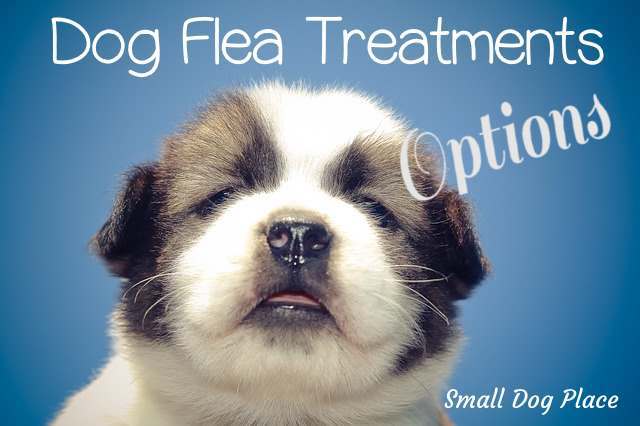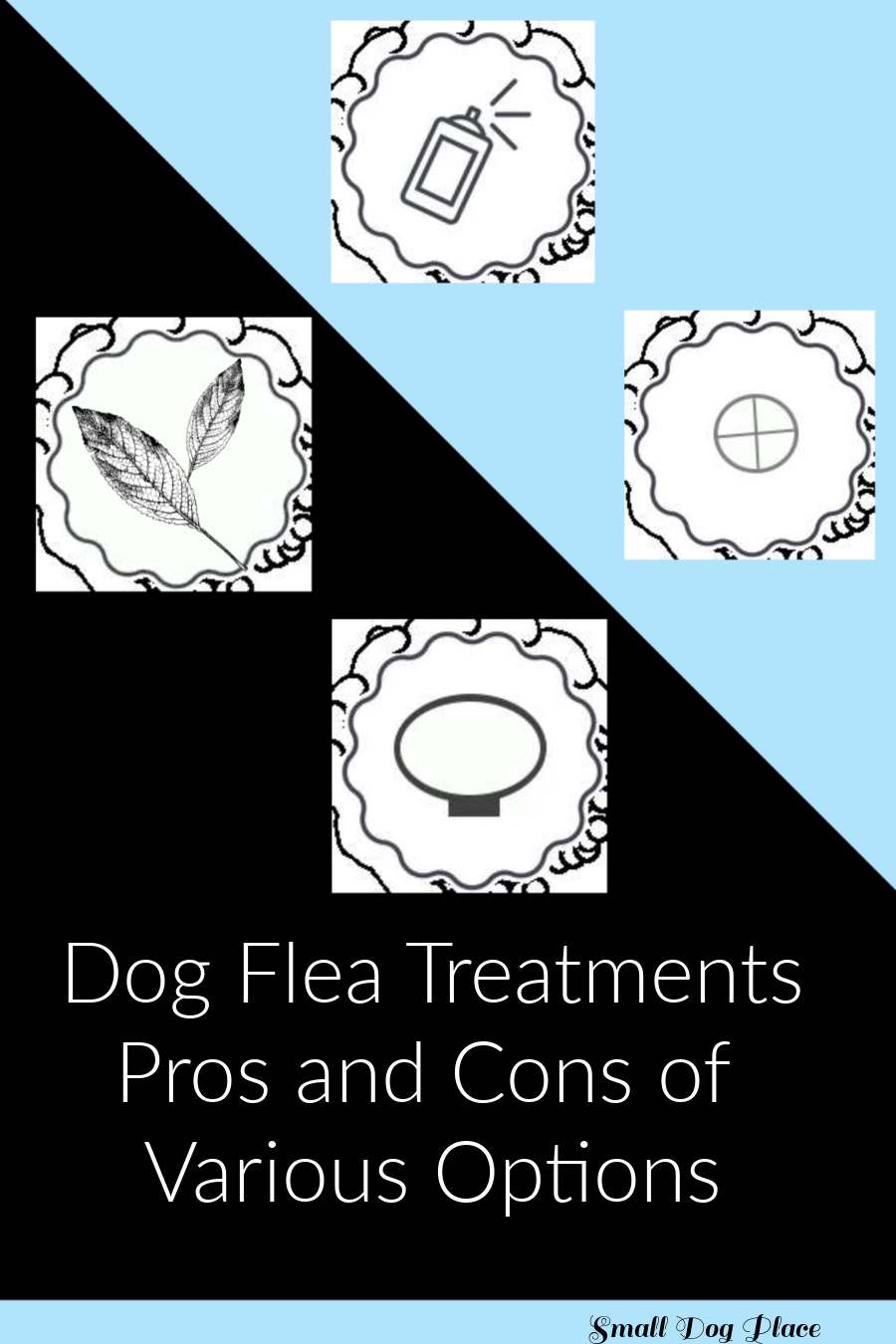Dog Flea Treatments By Alex Saunders |Updated 06-24-2024
Fleas might be small in size, but they can wreak havoc on your dog’s skin and cause him to itch and scratch like crazy! Even if you spotted just one tiny flea, you need to become proactive right now.
That one will multiply into hundreds of fleas and create a full-blown infestation in a few days.
 Dog Flea Treatments
Dog Flea TreatmentsLuckily, there are many flea treatments available that can help you eradicate these nasty pests. But with so many options, it can be hard deciding which flea treatment you should use for your dog.
Dog Flea Treatments
To help you get rid of dog fleas, we found and compared all flea treatment options available. Read on to find the one that will work for you!
Dog Flea Collars
Getting rid of fleas has never been easier – just put a flea collar on your dog and watch as these nasty pests wither and die. Flea collars are a great solution if you are looking for a convenient and long-lasting flea treatment for your dog.
While the majority of flea collars uses chemical pesticides to kill and prevent fleas, there are several natural flea collars available as well. Which is a great option if you like the convenience the flea collar brings, but don’t want to expose yourself of your dog to chemicals.
How Flea Collars Work
All dog flea collars work on the same approach and release smaller amounts of active ingredients over some time, thus keeping your dog protected against fleas. However, different flea collars have different lifespans and will generally keep your dog flea-free from 3 to 8 months.
You will be pleased to know that the majority of flea collars also kill ticks and prevents them from attaching to your dog again. So you are in fact, getting two products for the price of one!
Most dog flea collars will start killing any fleas on your dog within the first 24 hours, and some even kill larvae and eggs. Thus, preventing the flea cycle from completing and keeping your pooch pest free.
However, some flea collars will work only on adult fleas and won’t prevent further infestations. So, make sure that you read the label carefully to find the collar that is right for your needs.
With the improvements in flea collar technology, you no longer have to worry that the flea collar will stop working every time your dog gets wet. Newer flea collars are made to be water-resistant and continue to offer protection even if your dog takes a dip. However, keep in mind that frequent exposure to water can shorten the collar’s lifespan from 8 to 5 months.
Dog flea collars are designed to be completely safe for dogs, and it is highly unlikely that your dog will develop any issues wearing one for longer periods. Still, you should be careful using any chemical flea treatment if your dog has sensitive skin or allergies. If this is the case, you should opt for a natural flea collar or consider other flea treatment options.
Pros and Cons of Flea Collars
Pros:
- Provides long-lasting protection
- Easy to use
- – Kills fleas in all life stages
- Chemical and natural options
- Some models are water-resistant
- Also offers protection against ticks
Cons:
- A dog has to wear it all the time
- Can cause skin irritation
- Not completely waterproof
Topical Dog Flea Treatments
If you really hate the idea of your dog wearing a flea collar all the time, you should definitely try a topical flea treatment. While spot-on is the most popular topical flea treatment, flea sprays, powders, and shampoos are also in this category.
Let’s take a closer look at each of these treatments to help you find the right one for your dog:
Spot-on Dog Flea Treatments
Come in the form of a liquid that you need to squeeze on your dog’s neck for them to work. They are also the most effective, killing adult fleas, larvae and eggs, and offering protection for 30 days.
The most popular spot-on treatments will take 24 to 48 hours to start killing fleas, and they also work against ticks. However, they might not offer 30-day protection against them.
Most spot-on treatments will continue to work even if your dog gets wet a few times. However, you should wait at least 10 days after the application to bathe your pooch and avoid frequent baths since they shorten the spot-on’s efficiency.
The only downside of spot-on treatments is that they are a bit messy to apply and you will have to apply them every month to keep fleas at bay.
Dog Flea Treatments: Flea sprays
Are best to use in between baths since they will stop working once your dog gets wet. Both chemical and natural variations are available, and overall, both types are relatively efficient.
Flea sprays work by killing adult fleas, larvae, and eggs, and you can use them to treat your dog’s bedding or other household items.
Furthermore, they are fairly simple to use – simply spritz your dog’s coat from the neck down, making sure that the spray reaches the skin. For the head, apply the spray to a cloth and gently rub it, avoiding mouth, nose, and eyes.
Dog Flea Treatments: Flea powder
Is a powder that you sprinkle on your dog’s coat to kill fleas. Generally, the power will kill all living fleas in a couple of days as long as you leave it on your dog.
Since applying flea powders is messy work, it is best to do it outside your house as long as there is no wind. Overall, flea powders can offer a solution if no other flea treatment worked for you. But since they don’t provide protection and take up to a few days to kill all fleas, it is best if you use it as a last resort.
Dog Flea Treatments: Flea shampoos
Works on the same principle as regular dog shampoos but will also kill fleas. There are different types of flea shampoos, some will only kill adult fleas, while others also kill eggs and larvae.
For the best results, you will need to leave the shampoo to work for a couple of minutes before rinsing your dog’s coat thoroughly. And while some shampoos provide some short-term protection against fleas, most of them will only kill fleas. So you will have to find a suitable treatment that will keep your dog protected long-term.
Pros and Cons of Topical Flea Treatments
Pros:
- Cheaper than flea collars
- You can use shampoo, spray, or powder on several dogs
- Spot-on is water resistant
- Fast acting and kills fleas in all life stages
Cons:
- Needs to be applied regularly
- Short-term protection
- Hard to use
Dog Flea Treatments: Flea Pills
Flea pills are highly efficient at killing fleas and are the fastest acting among all flea treatments currently available. What’s also great, is that some flea pills prevent heartworms, intestinal parasites, and ticks, thus saving you money on several different treatments.
These oral flea treatments come in the form of a flavored soft chew, or beef-flavored tablet, which makes them convenient to use. Besides killing fleas, some pills will also provide up to 30 days of protection, while others have to be administered daily to keep your dog flea-free.
You should also know that most flea pills kill adult fleas, but not larvae and eggs, so you will need to apply an additional treatment get rid of fleas for good. Furthermore, many flea pills are prescription-only, and you will have to talk with your vet and decide if this is the best solution for your dog.
Pros and Cons of Flea Pills
Pros:
- Easy to administer
- Offers protection against heartworms and internal parasites
- Fast acting
- Quick solution for flea infestations
Cons:
- Most flea pills require a prescription
- Doesn’t kill larvae and eggs
All Natural Dog Flea Treatments
Although all flea and tick products are carefully regulated and controlled, you may be concerned about exposing your dog to toxic chemicals, and would rather use a more natural approach. Luckily, a lot of ingredients you already have at your home can help you get rid of fleas.
Here are a couple of natural flea treatments you will want to try:
Natural flea shampoo: Add a couple of drops of cedar, lemon, or lavender essential oil into your dog’s regular shampoo to get rid of fleas. Repeat as necessary if any fleas are left alive and then use it once a week to create a flea barrier.
Apple Cider Vinegar: Mix 50/50 apple cider vinegar and water and pour the mixture into a spray bottle. Sprinkle the solution on your dog’s coat until all fleas are dead.
Lemon: Cut and place 3 lemons in a pot and add 3 cups of water. Bring the mixture to boil and then let it simmer on medium heat for another 30 minutes. After that, remove the pot from the stove and leave the mixture to steep overnight.
In the morning, strain the lemons and pour the solution into a spray bottle. Spritz the solution onto your dog’s coat and let it air dry. If necessary, repeat until all fleas are gone.
DIY Flea collar: Mix two drops of rosemary, lavender, cedarwood, or lemon essential oil into a tablespoon of water. Apply that solution to your dog’s collar or a kerchief and tie it around your dog’s neck. Essential oils will kill any fleas residing on your dog and also work as a repellent. Refresh the collar once a week for long lasting protection.
Diatomaceous earth: Will kill adult fleas, larvae, and eggs, and you can also use it to treat your home. Dust your dog’s coat with DE powder and repeat every 3 days for the next month to get rid of fleas.
Keep in mind that while these natural flea remedies work, they aren’t as effective as other flea treatments and it may take some time until all fleas are gone. Once you are finally rid of them, use essential oils as flea repellants, if you don’t want to use any of the chemical-based options available.
Pros:
- Completely safe
- Inexpensive
- Can kill and repel fleas
Cons:
- The treatment has to be applied regularly
- Takes some time to see results
- Not as effective as chemical treatments
Conclusion: Dog Flea Treatments
There is nothing worse than finding fleas on your dog! But luckily, there is a variety of efficient flea treatments you can choose from to get rid of these nasty pests.
To be honest, there isn’t a single treatment that works for all dogs, and you will have to consider your unique situation and needs to find the one that is right for your dog. However, it is very important that you find the one that works for you to keep your dog protected against fleas and diseases they bring.
We covered all available flea treatments for dogs, and hopefully, you now have all the information you need to pick the right one and start killing fleas!
Author Bio: Dog Flea Treatments
Alex Saunders is a father of 2 and dog lover. He is the Editor In Chief at DoggieApproved.com a website that helps pet owners become more informed on the latest tips, buyer’s guides, technology, reviews, and more. You can read their most recent review on Dog Flea and Tick Collars
 Dog Flea Treatments Pin
Dog Flea Treatments PinDoes This Article Deserve Your Thumbs Up?
We always appreciate your support and encouragement. Your thumbs up means so much to us. Please like this article.
If you find this page or any page on Small Dog Place Helpful, or Useful in anyway, I’d love it if you would click the small heart found on the bottom right of each page.
You can also share or bookmark this page — just click on the:

Free Monthly Newsletter
Sign Up for Our Free Newsletter and get our Free Gift to You.
my E-book, The Top 10 Mistakes People Make When Choosing a Dog (and how to avoid them)


